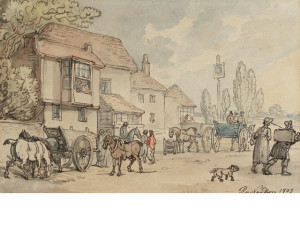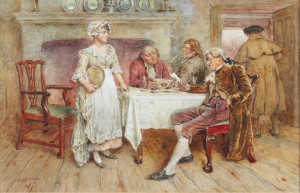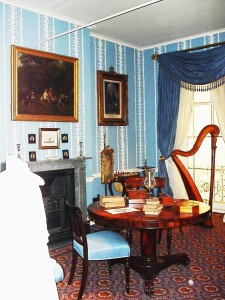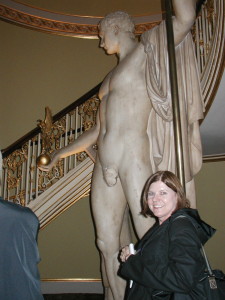There were different classes of inns in the 18th century and they

A Country Inn by Rowlandson
made quite strong distinctions between the patrons they would admit.
In Travellers in 18th Century England, Rosamond Bayne-Powell writes:
The traveller had his choice of inns but must select them with care. There were first, the grand establishments, the Posting Houses, which entertained the quality who travelled in their own carriages or in post-chaises. They might accommodate riding gentlemen if these were duly accompanied by their servants. Some of these inns accepted passengers from the mail coach, some did not; but they never stooped so low as to take in the common stage passenger. Those low people had to go to the inns which catered for them ; but they had the satisfaction of knowing that there were others of a still inferior order.The passenger in the wagon, the walker on foot, was seldom admitted or, if he were, was pushed into the kitchen and fed upon remains.
This “class system” in regard to inns caused confusion among foreign visitors to England, who were unaware that arriving on foot might bar them entry.
Pastor Karl Philip Moritz in his book Travels in England (1782) was very upset by the assumption that if he arrived on foot at an inn he was a man of no consequence, and was, accordingly, shabbily treated. He arrived at an inn at Windsor on foot and was appalled by the reception given:
As I entered the inn and desired to have something to eat, the countenance of the waiter soon gave me to understand that I should thee find no very friendly reception. Whatever I got they seemed to give me with such an air as showed how little they thought of me, and as if they considered me but a beggar. I must do them justice to own however, that they suffered me to pay like a gentleman. No doubt this was the first time that this pert , bepowdered puppy had ever been called upon to wait on a poor devil who entered their place on foot/
Moritz asked for a room and was shown one, as he remarked, that resembled a “prison for malefactors.” When he asked for a better one, he was told they had no room for such guests as he and it was suggested he go back to Slough. He decided to accept the room, which may have been a mistake, as it cost him 9 shillings to stay the night ,despite having to share the room with drunken old man who got into bed wearing his boots. Note that it was not uncommon for guests to be asked to share rooms at all classes of inns throughout the 18th century.
Pierre Jean Grosley in his book, A Tour to London or, New Observations on England, And its inhabitants (1772), wrote of how when staying at an inn in London he was woken at 3 a.m. in order that another guest could share his room and bed.
Moritz did get good service at the Mitre in Oxford, even though the arrived on foot, but this was probably because he was introduced to the inn’s staff by an Oxford clergyman who vouched for him.
According to Bayne-Powell, the lowest class of inn was the hedge-inn. These places took in as guests those who arrived on foot and wagon passengers. They charged between 9 pence – 1 shilling for bed and supper. Compare this with the extortionate charges poor Karl Mortiz paid at the Posting House at Windsor.
Until the end of the 18th century, the better type of inns did not have common dining rooms. A guest at this type of inn would normally have had the choice of hiring a private sitting room, if there was one to be had, or dining with the landlord and his family in their dining room, or even in the kitchen.
 However, at the end of the 18th century common dining rooms, or as they were known “coffee rooms” were introduced at the posting houses. In these common dining rooms it became customary to serve a set meal which became known as an “ordinary.”
However, at the end of the 18th century common dining rooms, or as they were known “coffee rooms” were introduced at the posting houses. In these common dining rooms it became customary to serve a set meal which became known as an “ordinary.”
The whole thing makes the modern Day’s Inn look pretty darned good. Where would you like to stay when you travel and how would you arrive?











